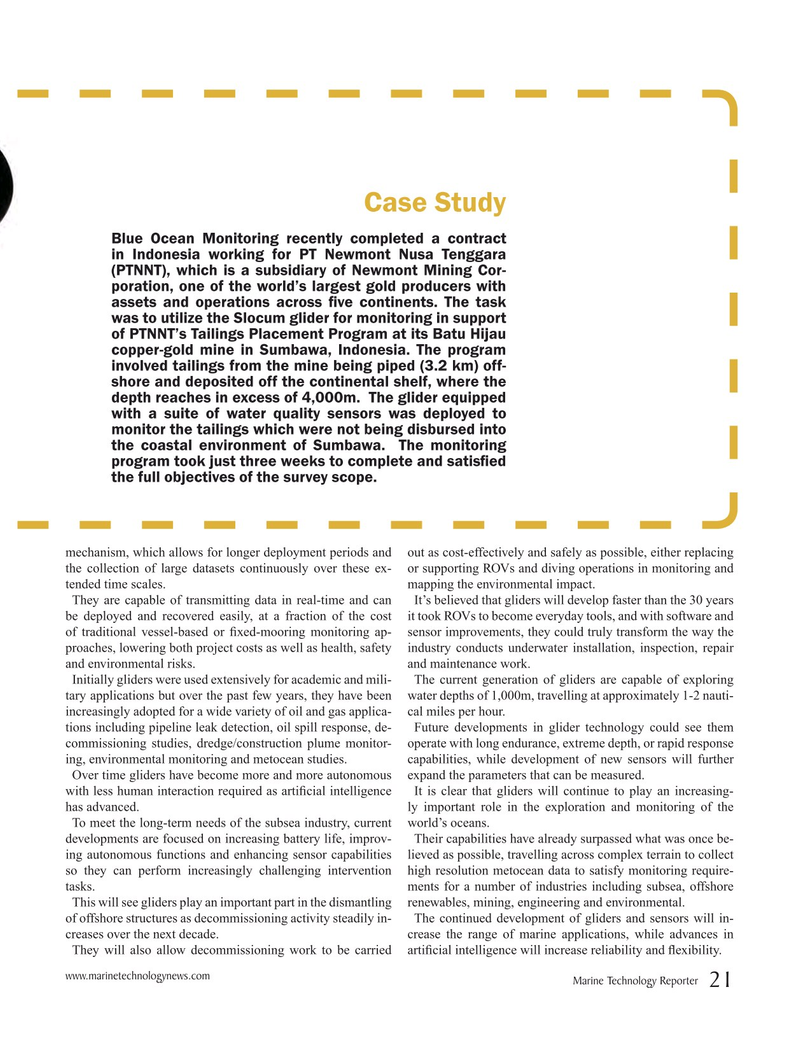
Page 21: of Marine Technology Magazine (October 2016)
AUV Operations
Read this page in Pdf, Flash or Html5 edition of October 2016 Marine Technology Magazine
Case Study
Blue Ocean Monitoring recently completed a contract in Indonesia working for PT Newmont Nusa Tenggara (PTNNT), which is a subsidiary of Newmont Mining Cor- poration, one of the world’s largest gold producers with assets and operations across ? ve continents. The task was to utilize the Slocum glider for monitoring in support of PTNNT’s Tailings Placement Program at its Batu Hijau copper-gold mine in Sumbawa, Indonesia. The program involved tailings from the mine being piped (3.2 km) off- shore and deposited off the continental shelf, where the depth reaches in excess of 4,000m. The glider equipped with a suite of water quality sensors was deployed to monitor the tailings which were not being disbursed into the coastal environment of Sumbawa. The monitoring program took just three weeks to complete and satis? ed the full objectives of the survey scope.
mechanism, which allows for longer deployment periods and out as cost-effectively and safely as possible, either replacing the collection of large datasets continuously over these ex- or supporting ROVs and diving operations in monitoring and tended time scales. mapping the environmental impact.
They are capable of transmitting data in real-time and can It’s believed that gliders will develop faster than the 30 years be deployed and recovered easily, at a fraction of the cost it took ROVs to become everyday tools, and with software and of traditional vessel-based or ? xed-mooring monitoring ap- sensor improvements, they could truly transform the way the proaches, lowering both project costs as well as health, safety industry conducts underwater installation, inspection, repair and environmental risks. and maintenance work.
Initially gliders were used extensively for academic and mili- The current generation of gliders are capable of exploring tary applications but over the past few years, they have been water depths of 1,000m, travelling at approximately 1-2 nauti- increasingly adopted for a wide variety of oil and gas applica- cal miles per hour. tions including pipeline leak detection, oil spill response, de- Future developments in glider technology could see them commissioning studies, dredge/construction plume monitor- operate with long endurance, extreme depth, or rapid response ing, environmental monitoring and metocean studies. capabilities, while development of new sensors will further
Over time gliders have become more and more autonomous expand the parameters that can be measured.
with less human interaction required as arti? cial intelligence It is clear that gliders will continue to play an increasing- has advanced. ly important role in the exploration and monitoring of the
To meet the long-term needs of the subsea industry, current world’s oceans. developments are focused on increasing battery life, improv- Their capabilities have already surpassed what was once be- ing autonomous functions and enhancing sensor capabilities lieved as possible, travelling across complex terrain to collect so they can perform increasingly challenging intervention high resolution metocean data to satisfy monitoring require- tasks. ments for a number of industries including subsea, offshore
This will see gliders play an important part in the dismantling renewables, mining, engineering and environmental.
of offshore structures as decommissioning activity steadily in- The continued development of gliders and sensors will in- creases over the next decade. crease the range of marine applications, while advances in
They will also allow decommissioning work to be carried arti? cial intelligence will increase reliability and ? exibility.
www.marinetechnologynews.com
Marine Technology Reporter 21
MTR #8 (18-33).indd 21 9/27/2016 1:47:39 PM

 20
20

 22
22
